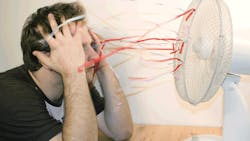On a hot summer morning in Kentucky in 2003, six laborers started work in a hot, humid warehouse to expand a manufacturing facility. When the workers took their 30-minute lunch break at noon, a 41-year-old certified welder walked to the air-conditioned trailer that was parked on site. He reportedly drank water but did not eat lunch before leaving the cool trailer and re-entering the 90-degree F environment to return to his work in the warehouse.
See Also: Environmental and Workplace Health Regulations & Standards
At 5:30 p.m., the welder was discovered in the parking lot. He had collapsed on the way to his car. He was rushed to a hospital, where it was determined his internal temperature had reached 108 degrees. Unfortunately, his body had reached the advanced stages of heat stroke and he passed away.
This example, provided by the Centers for Disease Control and Prevention (CDC), illustrates why heat stress is such a pressing issue for employers. Fortunately, training, education and information now are more readily available to help eliminate heat stress incidents. Additionally, advances in equipment have contributed improving working conditions in buildings such as warehouses, distribution centers, manufacturing plants, stadiums and food/beverage facilities.
Keeping Your Cool
Every year, thousands of employees become sick or perish due to heat stress. When our bodies are exposed to high temperatures, our internal temperature rises. If steps are not taken, our internal temperature continues to rise, which can lead to heat rash, heat cramps, heat exhaustion or a more serious medical emergency known as heat stroke. People with heart conditions or those who are overweight, over 65 years of age or older or have high blood pressure are more susceptible to heat stress.
When you combine high temperatures or high humidity with strenuous physical activity, you are upping the ante for a heat-related illness to occur. The American Conference of Governmental Industrial Hygienists stated that workers should not be permitted to work when their deep body temperature exceeds 100.4 degrees F (38 degrees C).
OSHA provides workers and employers useful information on occupational heat exposure, and CDC's Web site offers tips for workers and employers. The recommendations from OSHA and CDC emphasize the importance of cooling down the external and internal environments.
If heat stress symptoms occur, take the following steps:
➠ Stop physical activity and relax in a cool place.
➠ Drink plenty of fluids rich in salts and electrolytes to replace moisture loss through sweating.
➠ Use cool compresses to decrease temperature.
➠ In the event of suspected heat stroke, call 911.
Get a Move On
One of the best ways to eliminate the risk of heat stroke is to prevent it from occurring altogether. High-volume, low-speed fans (HVLS) are one solution. The main goal of a HVLS fan is to move air, which in turn cools the environment and makes employees feel more comfortable.
An HVLS fan's six-blade design produces a massive column of air that flows down toward the floor and outward in all directions before drawing it back vertically toward the blades to create what is known as a horizontal floor jet. This floor jet produces circulation benefits by creating a 2 to 3 mph breeze that delivers the equivalent of a 7-11 degree decrease in perceived temperature. The fan also breaks the moisture barrier on a worker's skin, reducing the perceived temperature by 8-10 degrees.
The cooler temperatures can make a big impact on the employees out on the floor. But how can you achieve this in a large facility with hundreds of employees? Or during the hot summer months, even in buildings with poor ventilation?
Cost-Effective Cooling
Freeman Exhibit Services prides itself on creating one-of-a-kind environments for conventions and expos throughout the country. When the time came to add more fans to the company's 85,000 square-foot distribution center in Dallas, Operations Manager Bill Carmickle had one main objective: cooling down his facility efficiently and cost effectively.
The Freeman distribution center was constantly active and full of workers. Combine this energy with heavy operating equipment and the sweltering heat of a Texan summer, and things heat up fast. After doing some research and demonstrating an HVLS fan's effectiveness using fog testing and airflow analysis, Carmickle was able to justify his new purchase of HVLS fans to upper management. It was the "horizontal floor jet" and its ability to efficiently cool large areas that sealed the deal for Carmickle and his team.
According to Carmickle, the HVLS fans "help keep the guys cooler and help keep us working longer hours during the hottest parts of the day."
Essentially, this should be any facility manager's main goal. Keeping employees cooler certainly cuts back on the potential for heat stress. Consequently, the comfort of cooler temperatures may increase employees' production levels.
To keep your work force cool, create a plan and include some of the following objectives:
➠ Ensure your staff is trained and knowledgeable of heat stress symptoms.
➠ Stay up to date with OSHA and CDC recommendations and implement their tips to prevent heat stress in your workplace.
➠ Strive to provide a comfortable work environment.
➠ Choose cost-effective equipment that will keep your employees cool.
Finally, remember that prevention is better than cure. Being vigilant and proactive should be part of every business strategy. Rather than waiting for an employee to suffer from a heat stress disorder and require time away from work, be proactive and prevent it. With the right equipment, you can maintain a safe and comfortable work environment even in the warmest weather.
Dan Linder is sales manager, HVLS fans, at Serco Fans. Visit http://www.sercofans.com to learn more.
